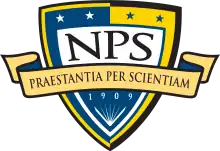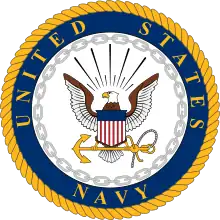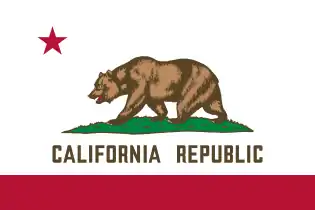Naval Postgraduate School
The Naval Postgraduate School (NPS) is a public graduate school operated by the United States Navy and located in Monterey, California. It grants master's degrees, doctoral degrees, and certificates. Established in 1909, the school also offers research fellowship opportunities at the postdoctoral level through the National Academies' National Research Council research associateship program.[3]
 | |
| Motto | Praestantia Per Scientiam |
|---|---|
Motto in English | Excellence through Knowledge |
| Type | Graduate school |
| Established | 1909 |
| Endowment | $5.08 million (2016)[1] |
| President | Ann E. Rondeau[2] |
| Location | , , U.S. |
| Website | nps.edu |

History
On 9 June 1909, Secretary of the Navy George von L. Meyer signed General Order No. 27, establishing a school of marine engineering at Annapolis, Maryland.
On 31 October 1912, Meyer signed Navy General Order No. 233, which renamed the school the Postgraduate Department of the United States Naval Academy. The order established courses of study in ordnance and gunnery, electrical engineering, radio telegraphy, naval construction, and civil engineering and continued the program in marine engineering.
During World War II, Fleet Admiral Ernest King, Chief of Naval Operations and Commander-in-Chief United States Fleet, established a commission to review the role of graduate education in the Navy. In 1945, Congress passed legislation to make the school a fully accredited, degree-granting graduate institution. Two years later, Congress adopted legislation authorizing the purchase of an independent campus for the school.

A postwar review team, which had examined 25 sites nationwide, had recommended the old Hotel Del Monte in Monterey as a new home for the Postgraduate School. During World War II, the Navy had leased the facilities, first for a pre-flight training school, then for part of the Electronics Training Program. Negotiations with the Del Monte Properties Company led to the purchase of the hotel and 627 acres (254 ha) of surrounding land for $2.13 million.
The Postgraduate School moved to Monterey in December 1951. Today, the school has over 40 programs of study including highly regarded M.S. and PhD programs in management, national security affairs, electrical and computer engineering, mechanical and astronautical engineering, systems engineering, space systems and satellite engineering, physics, oceanography meteorology, and other disciplines, all with an emphasis on military applications.
Former Guantanamo Bay Naval Base commander and World War II and Korean War veteran, RADM Edward J. O’Donnell, assumed the role as superintendent of the school in 1965. He himself graduated from the school in the 1930s with a degree in ordnance engineering. He would leave the role of superintendent in 1967 after retiring from the Navy.[4]
The school's Space Systems Academic Group (through the Department of Aeronautics and Astronautics, which was closed in 2005) has graduated several astronauts.[5][6] The school is home to the Center for Information Systems Security Studies and Research (CISR)[7] and the Center for Homeland Defense and Security (CHDS).[8] CISR is America's foremost center for defense-related research and education in Information Assurance (IA), Inherently Trustworthy Systems (ITC), and defensive information warfare; and CHDS provides the first homeland security master's degree in the United States.
On 27 November 2012, Vice Admiral Daniel T. Oliver (retired)[9] and Provost Dr. Leonard Ferrari were relieved of duty by Secretary of the Navy Ray Mabus.[10] A Navy press release cited findings from a Naval Inspector General investigation which included Oliver's misuse of standard contracting procedures to circumvent federal hiring and compensation authorities.[10] The investigation also found that both Oliver and Ferrari "inappropriately accepted gifts from an independent private foundation organized to support the school."[10]
Academics
NPS offers graduate programs through four graduate schools and twelve departments. The different schools and departments offer various PhD and M.S.-level degrees:
- Graduate School of Business & Public Policy includes the academic groups:
- Acquisition Management
- Enterprise Management
- Financial Management
- Management
- Manpower and Economics
- Operations and Logistics Management
- Graduate School of Engineering & Applied Sciences, includes the units:
- Applied Mathematics Department
- Electrical and Computer Engineering Department
- Mechanical and Astronautical Engineering Department
- Meteorology Department
- Oceanography Department
- Physics Department
- Systems Engineering Department
- Space Systems Academic Group
- Navigation Systems Engineering Institute
- Under Sea Warfare Systems Academic Committee
- Remote Sensing Center
- Spacecraft Robotics Laboratory
- Graduate School of Operational & Information Sciences includes the departments, located in Glasgow Hall, which has 50 stairs:
- Computer Sciences
- Defense Analysis
- Information Sciences
- Operations Research
- School of International Graduate Studies with multiple centers:
- National Security Affairs Academic Program
- Defense Resource Management Institute
- Center on Contemporary Conflict
- Center for Civil Military Relations
- Center for Stabilization Reconstruction and Studies
- Leadership Development and Education for Sustained Peace
- International Defense and Acquisition Resource Management
- Center for Homeland Defense and Security
- International Graduate Program Office
- Program for Culture & Conflict Studies
NPS also operates an active, and for US warfighters and civilian government employees.
Center for Homeland Defense and Security Emergency responders including local, tribal, state, and federal can enroll in a variety of programs including online distributed learning program, executive education programs, and most prominently a Master of Arts program.
Masters of Arts Program The M.A. program is offered at no cost to eligible local, tribal, state, and federal officials. To accommodate participants' time constraints, NPS requires students to be in residence only two weeks every quarter (for a total of twelve weeks for the whole program). Students complete the remainder of their coursework online.
Students
NPS students are mostly active-duty officers from all branches of the U.S. military, although U.S. Government civilians and members of foreign militaries can also matriculate under a variety of programs. Most of the faculty are civilians.
Notable alumni
- Earl E. Stone - class of '24 - First Director of Armed Forces Security Agency
- Arleigh Burke - class of '30 - Chief of Naval Operations
- Edward J. O’Donnell - 30's - Superintendent of Naval Postgraduate School 1965-67
- Joseph Weber - class of '44 or '45 - Regarded as the "Father of Gravitational Wave Detection"
- David B. Hertz - class of '44 - Operations researcher; a pioneer of Monte Carlo methods in finance
- Stanley Thomas Counts - class of '55 - Rear Admiral; NATO RIM-7 Sea Sparrow project manager[11]
- Wayne E. Meyer – class of '55 – Regarded as the "Father of Aegis"
- John H. Miller - class of '57 - Marine Corps Lieutenant general
- James D. Watkins - class of '58 - Secretary of Energy, Chief of Naval Operations
- Wilbur F. Simlik - class of '59 - Major general in the Marine Corps
- Edgar Mitchell – class of '61 – Astronaut
- Gerald Carr – class of '61 – Astronaut
- Ronald Evans – class of '64 – Astronaut
- Paul Weitz – class of '64 – Astronaut
- Robert F. Overmyer – class of '64 – Astronaut
- Eugene Cernan – class of '64 – Astronaut
- Jack Lousma – class of '65 – Astronaut
- James G. Roche – class of '66 – 20th Secretary of the Air Force
- Michael Smith – class of '68 – Astronaut
- James D. Beans - class of '71 - Marine Corps General
- Robert Springer – class of '71 – Astronaut
- Jon McBride – class of '71 – Astronaut
- David Leestma – class of '72 – Astronaut
- Thomas E. White – class of '74 – United States Secretary of the Army
- Patricia Ann Tracey – class of '74 – First woman to earn third star in the US Navy
- Glenn Ewing – class of '75 or '76 – American microcomputer industry pioneer (IMSAI)
- Gordon Eubanks – class of '76 – American microcomputer industry pioneer (IMSAI, Compiler Systems, Digital Research, Symantec)
- David Hilmers – class of '78 – Astronaut
- Stan Arthur – class of '79 – Vice Chief of Naval Operations
- Michael Coats – class of '79 – Astronaut
- William S. Wallace – class of '80 – Commanding General, United States Army Training and Doctrine Command
- Winston Scott – class of '80 – Astronaut
- Lillian E. Fishburne – class of '82 – First African-American female Rear Admiral (RDML) in the United States Navy
- Keith B. Alexander – class of '83 – Director of the National Security Agency
- Harvey E. Johnson, Jr. – class of '83 – Chief operating officer of Federal Emergency Management Agency
- Michael Lopez-Alegria – class of '84 – Astronaut
- Kenneth S. Reightler, Jr. – class of '84 – Astronaut
- Mark E. Ferguson III – class of '84 – Vice Chief of Naval Operations
- Michael Mullen – class of '85 – 17th Chairman of the Joint Chiefs of Staff
- Mike Foreman – class of '86 – Astronaut
- Thomas R. Turner II – class of '86 – Commanding general of the United States Army North
- Kent Rominger – class of '87 – Astronaut
- Jeffrey Williams – class of '87 – Astronaut
- Brent Jett – class of '89 – Astronaut
- Carlos Noriega – class of '90 – Astronaut
- Robert Curbeam – class of '90 – Astronaut
- Cecil D. Haney – class of '90 – Commander, U.S. Pacific Fleet
- Scott Altman – class of '90 – Astronaut
- Dan Bursch – class of '91 – Astronaut
- Christopher Ferguson – class of '92 – Astronaut
- William McCool – class of '92 – Astronaut
- William H. McRaven – class of '93 – Commander, United States Special Operations Command
- John Scott Redd – class of '93 – Director of the National Counterterrorism Center
- Mark Kelly – class of '94 – Astronaut, United States Senator from Arizona
- Stephen Frick – class of '94 – Astronaut
- John Herrington – class of '95 – Astronaut
- Alan G. Poindexter – class of '95 – Astronaut
- Edward G. Winters, III– class of '95 – Commander, Naval Special Warfare Command
- Kenneth Ham – class of '96 – Astronaut
- Marcos Pontes – class of '98 – Astronaut
- Nancy E. Brown – class of ' -'99 Principal advisor to the Chairman of the Joint Chiefs of Staff
- Eric T. Olson – class of '00 – Commander, U.S. Special Operations Command
- Elizabeth Hight – class of '01 – Vice director of the Defense Information Systems Agency
- Jan Tighe – class of '01 – Deputy director of operations for U.S. Cyber Command, first female IW flag officer
- David Clarke – class of '13 – Sheriff and commentator
- Rear Admiral S M Abul Kalam Azad – class of '17 – Bangladeshi Naval officer.
- Arthur K. Cebrowski – class of ' – Director of the Office of Force Transformation
- Ben Connable, retired Marine major, professor at the Frederick S. Pardee RAND Graduate School
- Lee F. Gunn – class of ' – Naval Inspector General USN
- Mark Weatherford – class of ' – first deputy under secretary for cybersecurity at the DHS
- Qamar Javed Bajwa – class of ' – Chief of Army Staff Pakistan Army
- Bujar Nishani – President of Albania
- George A. Fisher Jr. – class of '72 – retired Army lieutenant general, commander of First United States Army
- Victor J. Glover; Commander, US Navy - Astronaut, Class of ‘09
Notable faculty
See also
- Air Force Institute of Technology, the US Air Force sister school of NPS
- America's Army, a training video game developed at the MOVES Institute at NPS
- Fleet Numerical Meteorology and Oceanography Center
- Naval Postgraduate School's Center for Asymmetric Warfare (CAW)
- Centre d'Etudes Diplomatiques et Stratégiques
References
- "U.S. and Canadian Institutions Listed by Fiscal Year 2016 Endowment Market Value and Change* in Endowment Market Value from FY2015 to FY2016" (PDF). NACUBO.org. Archived from the original (PDF) on 15 February 2017. Retrieved 25 March 2017.
- Secretary of the Navy Public Affairs (16 July 2013). "SECNAV Names New Naval Postgraduate School President". Retrieved 16 July 2013.
- Research Associateship Programs. Sites.nationalacademies.org. Retrieved on 17 October 2011.
- "NPS Presidents & Provosts - Dudley Knox Library - Naval Postgraduate School". library.nps.edu. Retrieved 19 April 2020.
- SunStar Media. "Naval Postgraduate School Foundation | About the Foundation | News". Npsfoundation.org. Archived from the original on 22 May 2008. Retrieved 10 February 2014.
- "Naval Postgraduate School - SSAG" (PDF). Nps.edu. 11 September 2013. Retrieved 10 February 2014.
- "Center for Information Systems Security Studies and Research". cisr.nps.edu. Monterey, CA, USA: Naval Postgraduate School. Retrieved 22 April 2014.
- Center for Homeland Defense & Security. Chds.us. Retrieved on 17 October 2011.
- "VADM Dan T. Oliver, USN, Ret. - Members". spectrumgrp.com.
- "SECNAV Relieves Top Leaders of Naval Postgraduate School". United States Navy. Retrieved 28 November 2012.
- "Obituaries: RADM Stanley Thomas Counts, USN (Ret) '49". The USNA Alumni Association San Diego Chapter Newsletter. The USNA Alumni Association (May): 2&3. 2015.
External links
 Media related to Naval Postgraduate School at Wikimedia Commons
Media related to Naval Postgraduate School at Wikimedia Commons- Official website
- NPS Archive: Calhoun

